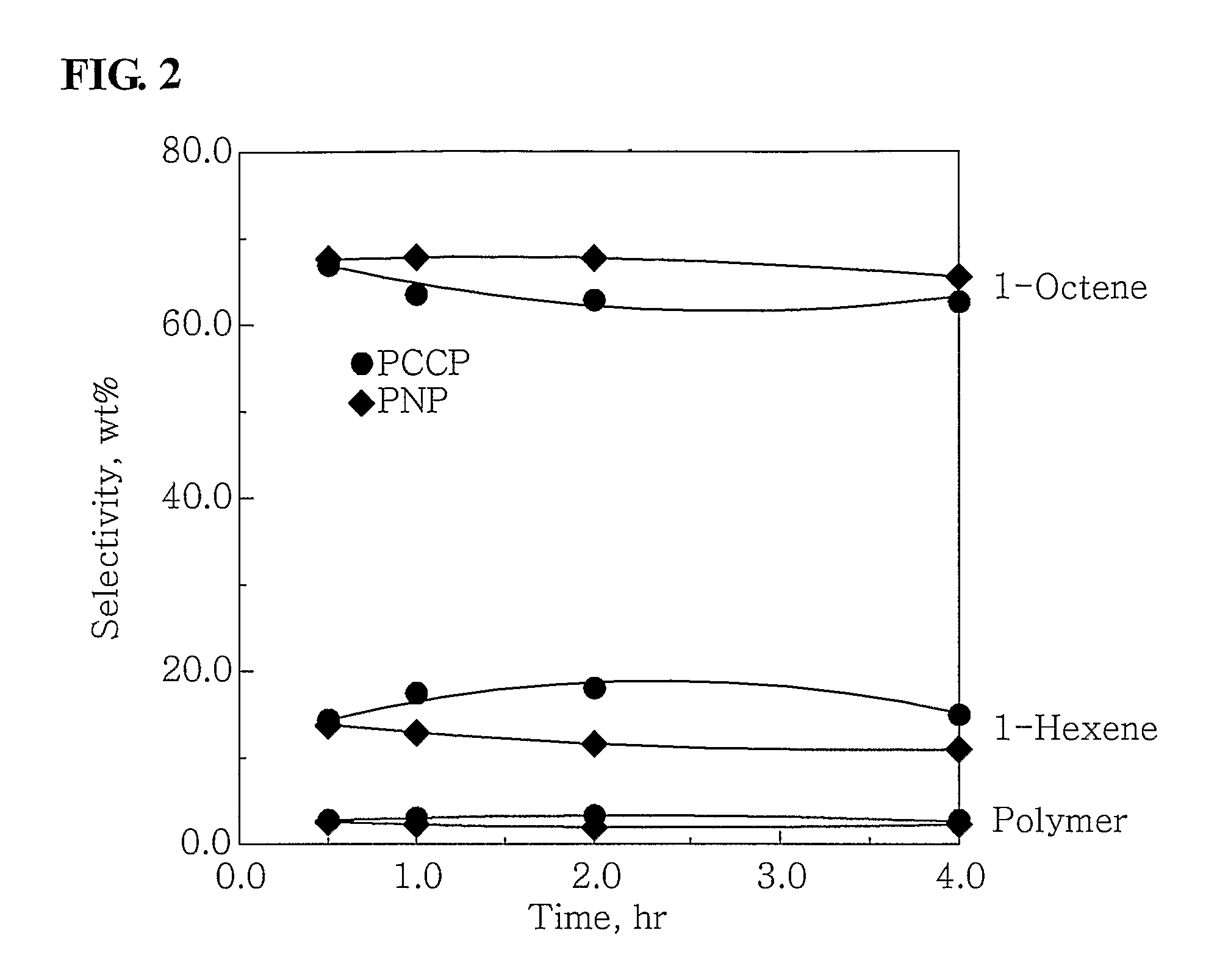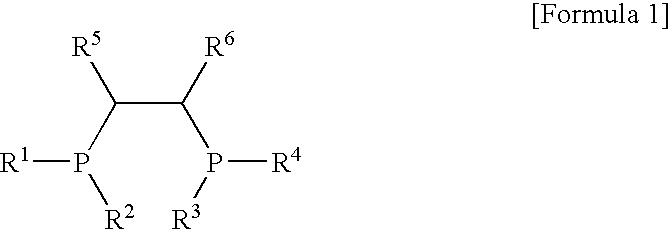Ethylene tetramerization catalyst systems and method for preparing 1-octene using the same
a technology of ethylene tetramerization and catalyst system, which is applied in the direction of hydrocarbon preparation catalyst, organic compound/hydride/coordination complex catalyst, physical/chemical process catalyst, etc., can solve the problems of inefficient ethylene oligomerization reaction, and limited yield of desired products, so as to achieve high 1-octene selectivity, high catalytic activity, and stable activity of chromium-based catalyst system
- Summary
- Abstract
- Description
- Claims
- Application Information
AI Technical Summary
Benefits of technology
Problems solved by technology
Method used
Image
Examples
example 1
Tetramerization of Ethylene Using Cr(III)(acetylacetonate)3, (phenyl)2PCH(methyl)CH(methyl)P(phenyl)2 and MAO
[0050]100 ml of cyclohexane and 4.0 mmol-Al of MAO were put into a 300 ml stainless steel reactor, which had been washed in nitrogen or in a vacuum, and were then heated to a temperature of 45° C. 3.5 mg (0.010 mmol) of Cr(III)(acetylacetonate)3 in 10 ml of toluene was put into a 50 ml Schlenk flask in a glove box and then mixed with 4.3 mg (0.010 mmol) of (phenyl)2PCH(methyl)CH(methyl)P(phenyl)2, obtained in Catalyst Preparation Example 1, to form a mixture, and then the mixture was stirred at room temperature for 5 minutes and then added to the reactor. Subsequently, ethylene was charged in the reactor at a pressure of 30 bar, and then stirred at a stirring speed of 600 rpm. After 30 minutes, the supply of ethylene and the stirring thereof were stopped, and the reactor was cooled to a temperature of less than 10° C.
[0051]Subsequently, excess ethylene was discharged from the...
example 2
Tetramerization of Ethylene Using Cr(III)(acetylacetonate)3, (phenyl)2PCH(methyl)CH(methyl)P(phenyl)2 and MAO
[0052]100 ml of cyclohexane and 2.0 mmol-Al of MAO were put into the 300 ml stainless steel reactor of Example 1, which had been washed in nitrogen or in a vacuum, and were then heated to a temperature of 45° C. 0.7 mg (0.002 mmol) of Cr(III)(acetylacetonate)3 in 10 ml of toluene was put into a 50 ml Schlenk flask in a glove box and then mixed with 0.86 m (0.002 mmol) of (phenyl)2PCH(methyl)CH(methyl)P(phenyl)2, obtained in Catalyst Preparation Example 1, to form a mixture, and then the mixture was stirred at room temperature for 5 minutes and then added to the reactor. Subsequently, ethylene was charged in the reactor at a pressure of 30 bar, and then stirred at a stirring speed of 600 rpm. After 30 minutes, the supply of ethylene and the stirring thereof were stopped, and the reactor was cooled to a temperature of less than 10° C.
[0053]Subsequently, excess ethylene was disc...
example 3
Tetramerization of Ethylene Using CrCl3(tetrahydrofuran)3, (phenyl)2PCH(methyl)CH(methyl)P(phenyl)2 MAO
[0054]100 ml of cyclohexane and 4.0 mmol-Al of MAO were put into the 300 ml stainless steel reactor of Example 1, which had been washed in nitrogen or in a vacuum, and were then heated to a temperature of 45° C. 3.75 mg (0.01 mmol) of CrCl3(tetrahydrofuran)3 in 10 ml of toluene was put into a 50 ml Schlenk flask in a glove box and then mixed with 4.3 mg (0.01 mmol) of (phenyl)2PCH(methyl)CH(methyl)P(phenyl)2, obtained in Catalyst Preparation Example 1, to form a mixture, and then the mixture was stirred at room temperature for 5 minutes and then added to the reactor. Subsequently, ethylene was charged in the reactor at a pressure of 30 bar, and then stirred at a stirring speed of 600 rpm. After 30 minutes, the supply of ethylene and the stirring thereof were stopped, and the reactor was cooled to a temperature of less than 10° C.
[0055]Subsequently, excess ethylene was discharged fr...
PUM
| Property | Measurement | Unit |
|---|---|---|
| reaction rate | aaaaa | aaaaa |
| temperature | aaaaa | aaaaa |
| temperature | aaaaa | aaaaa |
Abstract
Description
Claims
Application Information
 Login to View More
Login to View More - R&D
- Intellectual Property
- Life Sciences
- Materials
- Tech Scout
- Unparalleled Data Quality
- Higher Quality Content
- 60% Fewer Hallucinations
Browse by: Latest US Patents, China's latest patents, Technical Efficacy Thesaurus, Application Domain, Technology Topic, Popular Technical Reports.
© 2025 PatSnap. All rights reserved.Legal|Privacy policy|Modern Slavery Act Transparency Statement|Sitemap|About US| Contact US: help@patsnap.com



